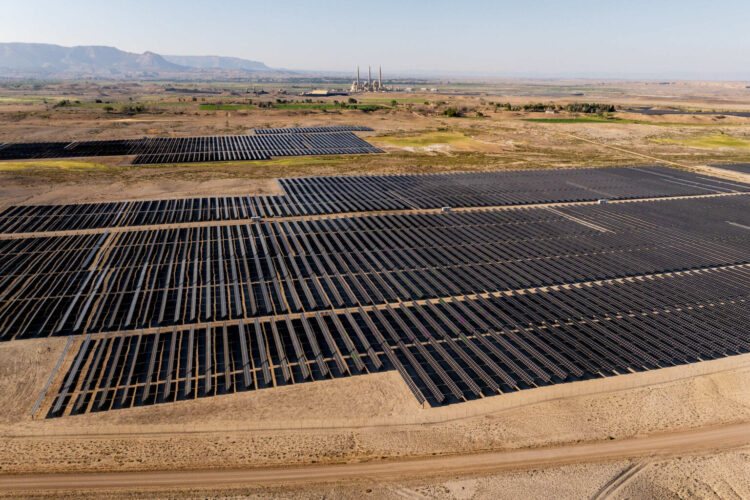Utah lawmakers to consider more solar power regulations and community benefits next year

Photo by Spenser Heaps for Utah News Dispatch
A solar installation in Emery County, with PacifiCorp’s Hunter coal-fired power plant in the background, is pictured on Wednesday, July 31, 2024.Utah lawmakers are eyeing more policy changes to further regulate renewable energy producers in the state, starting by disincentivizing the presence of solar farms in fields that could be “productive,” and adding a requirement to contribute to the communities that surround them.
It’s a theme the industry saw in the last legislative session. Legislators and developers had tense exchanges over a substantial conservation tax on private solar and wind generation facilities. Additionally, a bill that would reduce solar plants’ eligibility for state incentives ended up dying on the Senate floor because of lack of time, but next year it is expected to get fast tracked.
St. George Republican Rep. Colin Jack’s bill draft on solar power plants made big changes from its original idea — which established permitting requirements for location, size, setbacks, noise and visual appearance — that for clean energy advocates, was too strict. Now the bill mostly focuses on which renewable energy developments won’t have state-sponsored tax credits — those on “prime farmland.”
“(Farmers and ranchers) came to me and expressed a concern that in their counties they were seeing prime crop land and grazing land being covered up with big fields of solar panels,” Jack said at a Thursday interim meeting. “And they were saying there’s lots of land in this county that can’t grow anything. Why don’t we put the solar panels over there and not over here, where there’s cropland?”
The first version of the bill had issues, Jack said, because the state isn’t able to limit uses on private property. But, lawmakers could still limit state incentives for what the Natural Resources Conservation Service’s soil survey considers to be productive cropland.
The Public Utilities, Energy, and Technology Interim Committee voted 9-5 to adopt the bill as a committee bill, meaning it could be fast-tracked in the legislative process in 2026.
In the meantime, clean energy experts still worry the proposal would have negative effects on the state’s quest to multiply its energy production.
“At a time when strengthening domestic energy production is critical to both national security and economic growth, we should be expanding access to affordable, homegrown power, not hindering it,” Logan Mitchell, energy analyst at Utah Clean Energy said in a statement. “This bill would limit opportunities for Utah farmers to diversify their income through long-term lease payments for energy development.”
Next session, Sen. Derrin Owens, R-Fountain Green, is sponsoring another bill requiring energy producers to give back to Utah communities, he said during the interim meeting.
“Using our airshed and sending 99% of the power to California, and we get 100% of whatever pollution is there,” he said, “…those days have to be over.”
The role of renewables
Owens referred to his proposal after presentations from the Interwest Energy Alliance, a renewable energy advocate organization, and the Utah Association of Counties on the role of sources like solar and wind in the state. The groups then argued that the social benefits of the solar farms are seen mostly at the local level because of how the state’s tax code is written.
Lincoln Shurtz, a lobbyist for the Utah Association of Counties, said that any energy project that’s not a regulated utility in the state is assessed for taxes at the local level, not through the centrally assessed tax process.
Under the state law, counties, cities and districts won’t benefit from new growth on the developments’ tangible investment, like new solar arrays and equipment put in the land, unless they are put in a “community reinvestment area.”
With that designation, counties are able to sign community benefit agreements with solar developers, calculating their new growth and tracing a path for reinvesting the revenue in communities.
“In many circumstances, that’s how we’re putting in the infrastructure within the counties or the cities, whether that be transportation infrastructure within our counties, without having to raise taxes,” Shurtz said. “In many circumstances, that’s how we’re paying for the police department or the fire department or the EMS services within our communities.”
But, Republicans in the committee remained skeptical, arguing that solar power plants take larger footprints of land than other energy producers.
“There is an environmental impact to placing them and where we place them,” Sen. Scott Sandall, R-Tremonton, said. “They’re better on rooftops. They’re better on places where we’re already industrialized, in my opinion.”
But, mostly, Sandall said he’d be cautious about whether solar projects will be sustainable once tax credits go away in a couple of years. According to a study by Lazard, a financial firm, they will.
“Even with the tax credits going away for wind and solar, wind, solar storage continue to be amongst the most cost competitive resources on the market today,” Rikki Seguin, executive director at Interwest Energy Alliance said.
Renewables are often cheaper than conventional resources, Seguin said in her presentation to the committee. Without federal tax credits that expire in 2027 and state incentives that stop in 2028, the price of new solar and wind builds would be competitive with new gas generation. And sometimes bringing a new renewable development may be cheaper than operating an existing thermal facility.
“I’m not telling you to turn off a thermal facility. That’s not my presentation here today,” she said. “It is just to say if you need more power, which is what I think we’re all saying we need, you can build renewables very affordably on your system and help keep costs low and stable.”



